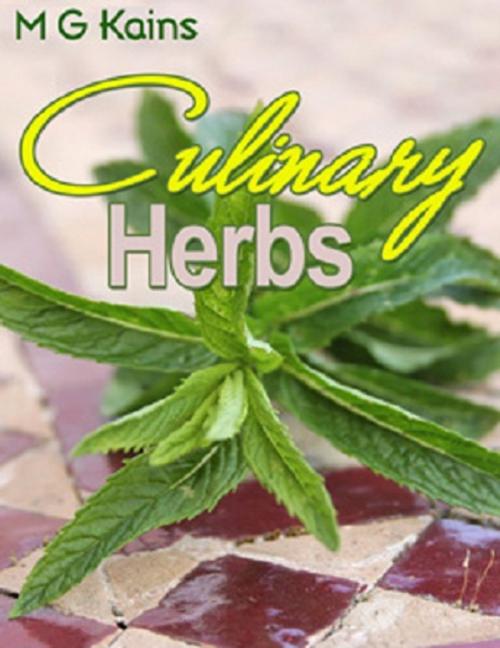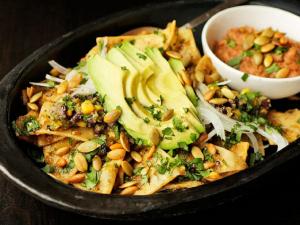Culinary Herbs
Nonfiction, Home & Garden, Gardening, Herbs, Science & Nature, Technology, Agriculture & Animal Husbandry| Author: | M. G. Kains | ISBN: | 1230000270960 |
| Publisher: | Consumer Oriented Ebooks Publisher | Publication: | September 29, 2014 |
| Imprint: | Language: | English |
| Author: | M. G. Kains |
| ISBN: | 1230000270960 |
| Publisher: | Consumer Oriented Ebooks Publisher |
| Publication: | September 29, 2014 |
| Imprint: | |
| Language: | English |
A small boy who wanted to make a good impression once took his little sweetheart to an ice cream parlor. After he had vainly searched the list of edibles for something within his means, he whispered to the waiter, “Say, Mister, what you got that looks tony an' tastes nice for nineteen cents?”
This is precisely the predicament in which many thousand people are today. Like the boy, they have skinny purses, voracious appetites and mighty yearnings to make the best possible impression within their means. Perhaps having been “invited out,” they learn by actual demonstration that the herbs are culinary magicians which convert cheap cuts and “scraps” into toothsome dainties. They are thus aroused to the fact that by using herbs they can afford to play host and hostess to a larger number of hungry and envious friends than ever before.
Maybe it is mainly due to these yearnings and to the memories of mother's and grandmother's famous dishes that so many inquiries concerning the propagation, cultivation, curing and uses of culinary herbs are asked of authorities on gardening and cookery; and maybe it is because no one has really loved the herbs enough to publish a book on the subject. That herbs are easy to grow I can abundantly attest, for I have grown them all. I can also bear ample witness to the fact that they reduce the cost of high living, if by that phrase is meant pleasing the palate without offending the purse.
For instance, a few days ago a friend paid twenty cents for soup beef, and five cents for “soup greens.” The addition of salt, pepper and other ingredients brought the initial cost up to twenty−nine cents. This made enough soup for ten or twelve liberal servings. The lean meat removed from the soup was minced and mixed with not more than ten cents' worth of diced potatoes, stale bread crumbs, milk, seasoning and herbs before being baked as a supper dish for five people, who by their bland smiles and “scotch plates” attested that the viands both looked “tony” and tasted nice.
I am glad to acknowledge my thanks to Mr. N. R. Graves of Rochester, N. Y., and Prof. R. L. Watts of the Pennsylvania State Agricultural College, for the photographic illustrations, and to Mr. B. F. Williamson, the Orange Judd Co.'s artist, for the pen and ink drawings which add so much to the value, attractiveness and interest of these pages.
If this book shall instill or awaken in its readers the wholesome though “cupboard” love that the culinary herbs deserve both as permanent residents of the garden and as masters of the kitchen, it will have accomplished the object for which it was written.
M. G. KAINS. New York, 1912.
A small boy who wanted to make a good impression once took his little sweetheart to an ice cream parlor. After he had vainly searched the list of edibles for something within his means, he whispered to the waiter, “Say, Mister, what you got that looks tony an' tastes nice for nineteen cents?”
This is precisely the predicament in which many thousand people are today. Like the boy, they have skinny purses, voracious appetites and mighty yearnings to make the best possible impression within their means. Perhaps having been “invited out,” they learn by actual demonstration that the herbs are culinary magicians which convert cheap cuts and “scraps” into toothsome dainties. They are thus aroused to the fact that by using herbs they can afford to play host and hostess to a larger number of hungry and envious friends than ever before.
Maybe it is mainly due to these yearnings and to the memories of mother's and grandmother's famous dishes that so many inquiries concerning the propagation, cultivation, curing and uses of culinary herbs are asked of authorities on gardening and cookery; and maybe it is because no one has really loved the herbs enough to publish a book on the subject. That herbs are easy to grow I can abundantly attest, for I have grown them all. I can also bear ample witness to the fact that they reduce the cost of high living, if by that phrase is meant pleasing the palate without offending the purse.
For instance, a few days ago a friend paid twenty cents for soup beef, and five cents for “soup greens.” The addition of salt, pepper and other ingredients brought the initial cost up to twenty−nine cents. This made enough soup for ten or twelve liberal servings. The lean meat removed from the soup was minced and mixed with not more than ten cents' worth of diced potatoes, stale bread crumbs, milk, seasoning and herbs before being baked as a supper dish for five people, who by their bland smiles and “scotch plates” attested that the viands both looked “tony” and tasted nice.
I am glad to acknowledge my thanks to Mr. N. R. Graves of Rochester, N. Y., and Prof. R. L. Watts of the Pennsylvania State Agricultural College, for the photographic illustrations, and to Mr. B. F. Williamson, the Orange Judd Co.'s artist, for the pen and ink drawings which add so much to the value, attractiveness and interest of these pages.
If this book shall instill or awaken in its readers the wholesome though “cupboard” love that the culinary herbs deserve both as permanent residents of the garden and as masters of the kitchen, it will have accomplished the object for which it was written.
M. G. KAINS.
A small boy who wanted to make a good impression once took his little sweetheart to an ice cream parlor. After he had vainly searched the list of edibles for something within his means, he whispered to the waiter, “Say, Mister, what you got that looks tony an' tastes nice for nineteen cents?”
This is precisely the predicament in which many thousand people are today. Like the boy, they have skinny purses, voracious appetites and mighty yearnings to make the best possible impression within their means. Perhaps having been “invited out,” they learn by actual demonstration that the herbs are culinary magicians which convert cheap cuts and “scraps” into toothsome dainties. They are thus aroused to the fact that by using herbs they can afford to play host and hostess to a larger number of hungry and envious friends than ever before.
Maybe it is mainly due to these yearnings and to the memories of mother's and grandmother's famous dishes that so many inquiries concerning the propagation, cultivation, curing and uses of culinary herbs are asked of authorities on gardening and cookery; and maybe it is because no one has really loved the herbs enough to publish a book on the subject. That herbs are easy to grow I can abundantly attest, for I have grown them all. I can also bear ample witness to the fact that they reduce the cost of high living, if by that phrase is meant pleasing the palate without offending the purse.
For instance, a few days ago a friend paid twenty cents for soup beef, and five cents for “soup greens.” The addition of salt, pepper and other ingredients brought the initial cost up to twenty−nine cents. This made enough soup for ten or twelve liberal servings. The lean meat removed from the soup was minced and mixed with not more than ten cents' worth of diced potatoes, stale bread crumbs, milk, seasoning and herbs before being baked as a supper dish for five people, who by their bland smiles and “scotch plates” attested that the viands both looked “tony” and tasted nice.
I am glad to acknowledge my thanks to Mr. N. R. Graves of Rochester, N. Y., and Prof. R. L. Watts of the Pennsylvania State Agricultural College, for the photographic illustrations, and to Mr. B. F. Williamson, the Orange Judd Co.'s artist, for the pen and ink drawings which add so much to the value, attractiveness and interest of these pages.
If this book shall instill or awaken in its readers the wholesome though “cupboard” love that the culinary herbs deserve both as permanent residents of the garden and as masters of the kitchen, it will have accomplished the object for which it was written.
M. G. KAINS. New York, 1912.
A small boy who wanted to make a good impression once took his little sweetheart to an ice cream parlor. After he had vainly searched the list of edibles for something within his means, he whispered to the waiter, “Say, Mister, what you got that looks tony an' tastes nice for nineteen cents?”
This is precisely the predicament in which many thousand people are today. Like the boy, they have skinny purses, voracious appetites and mighty yearnings to make the best possible impression within their means. Perhaps having been “invited out,” they learn by actual demonstration that the herbs are culinary magicians which convert cheap cuts and “scraps” into toothsome dainties. They are thus aroused to the fact that by using herbs they can afford to play host and hostess to a larger number of hungry and envious friends than ever before.
Maybe it is mainly due to these yearnings and to the memories of mother's and grandmother's famous dishes that so many inquiries concerning the propagation, cultivation, curing and uses of culinary herbs are asked of authorities on gardening and cookery; and maybe it is because no one has really loved the herbs enough to publish a book on the subject. That herbs are easy to grow I can abundantly attest, for I have grown them all. I can also bear ample witness to the fact that they reduce the cost of high living, if by that phrase is meant pleasing the palate without offending the purse.
For instance, a few days ago a friend paid twenty cents for soup beef, and five cents for “soup greens.” The addition of salt, pepper and other ingredients brought the initial cost up to twenty−nine cents. This made enough soup for ten or twelve liberal servings. The lean meat removed from the soup was minced and mixed with not more than ten cents' worth of diced potatoes, stale bread crumbs, milk, seasoning and herbs before being baked as a supper dish for five people, who by their bland smiles and “scotch plates” attested that the viands both looked “tony” and tasted nice.
I am glad to acknowledge my thanks to Mr. N. R. Graves of Rochester, N. Y., and Prof. R. L. Watts of the Pennsylvania State Agricultural College, for the photographic illustrations, and to Mr. B. F. Williamson, the Orange Judd Co.'s artist, for the pen and ink drawings which add so much to the value, attractiveness and interest of these pages.
If this book shall instill or awaken in its readers the wholesome though “cupboard” love that the culinary herbs deserve both as permanent residents of the garden and as masters of the kitchen, it will have accomplished the object for which it was written.
M. G. KAINS.















